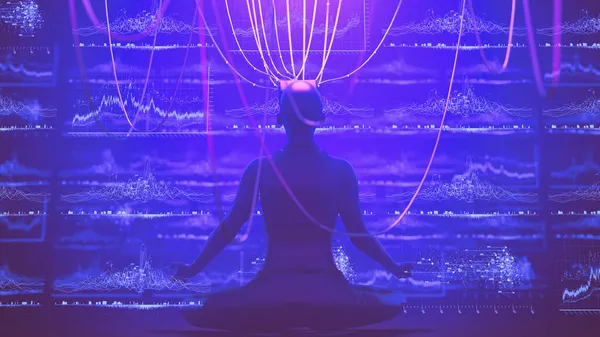Synchronicity: Denying The Unexplainable

Image Source: DepositPhotos
Musk’s been loud about the singularity—AI surpassing human intelligence, potentially soon, like within decades; exponential tech growth, Moore’s Law on steroids, and data from 2025 showing AI systems like GROK, getting sharper daily. Musk is betting Neuralink’s the bridge—wiring AI into our skulls for a symbiotic boost, merging wetware with hardware so we don’t get left behind by how we amplify cognition, fix neurological gaps, or even redefine what “human” means.
Now, synchronicity—Carl Jung’s idea of meaningful coincidences, events linked not by cause but by significance—feels like it’s knocking on the same door. It’s less about tech and more about the universe winking at us, but there’s a crossover. Musk’s singularity is mechanistic: AI and brain chips forcing a leap. Synchronicity’s more mystical: patterns aligning beyond logic. Maybe it’s a random association, maybe it’s not—but AI does focus on patterns too.
Picture this: Neuralink hooks you up, syncing your thoughts with an AI. Suddenly, you’re not just recalling conversations—you’re pulling insights from a cloud-mind, with gaps filled instantly. That’s Musk’s symbiosis, a forced alignment of human and machine. Now layer in synchronicity: what if those connections start sparking “coincidences”? You think of synchronicity, a riff on it now, and the next day some X post or web hit ties it all up—uncaused, yet dead-on. Is that just tech smoothing the edges, or something deeper nudging the cosmic pieces together?
Take 2025’s lens: Neuralink’s trials are rolling—early February reports show patients moving cursors with brain signals, crude but real. AI’s churning through datasets, predicting trends, sometimes eerily spot-on. Synchronicity could be the ghost in that machine— not programmed, but emergent. Say a Neuralink user dreams of a solution, wakes up, and their AI sync delivers it—causality’s blurry there. Jung would call it acausal; Musk would call it a feature, not a bug.
Age might scramble recall, but it also tunes you to patterns—haphazard or not. Denial fits too: we deny synchronicity because it’s unprovable, uncomfortable, like Nixon dodging Watergate’s dots. Yet if Neuralink amps our perception, maybe we’ll spot those winks clearer—symbiosis not just with AI, but with whatever’s orchestrating the coincidences. The singularity might not just be intelligence exploding; it could be meaning snapping into focus.
Synchronicity hints the universe might be in the singularity game believe it or not, Neuralink or not.
Denying the unexplainable isn’t about truth’s absence; it’s about dodging the hard slog of wrestling with the improbable. It’s not a veracity fight—it’s a comfort grab. Unpacking something like synchronicity, or even Musk’s singularity via Neuralink, demands effort: amplifying weak signals, stripping out bias, and chasing curiosity down rabbit holes. Most don’t want the workout. They’d rather shrug it off than sweat through the “what if.” And that’s where your second punch lands: why are we losing our curiosity?
It’s not that we can’t handle the improbable—humans have stared down wild unknowns forever, from fire to quantum quirks. But today, 2025, curiosity’s taking hits. One, we’re drowning in instant answers—AI like me, X posts, web searches spit out facts so fast we skip the wondering part. Why dig when Google’s got it? Two, comfort’s king. The improbable—say, synchronicity aligning your thoughts with some cosmic nudge—asks us to risk looking dumb or crazy. Nixon denied Watergate not because evidence wasn’t there, but because probing it cracked his cozy narrative. Same deal here: wrestling the unexplainable feels like a threat to our tidy worldviews.
Then there’s overload. Look at X—February’s buzzing with Neuralink updates, AI hype, political noise. Curiosity needs space to breathe, but we’re choking on info. Amplifying the odd takes focus; instead, we scroll past. Bias doesn’t help—Fauci’s fans and foes dig in, less curious about truth than winning. Extricating that takes guts, not just smarts, and courage is weak when denial’s more comfortable.
Are we losing it, though? Not entirely. Kids still ask “why” until adults shut them down. But collectively, it’s waning. Schools drill answers over questions. Jobs reward execution, not exploration. We’d rather dunk on the improbable than dissect it—mocking Harris’s gaffes beats pondering her economic denial’s roots. Curiosity is work, and we’re getting stupified.
Denial’s the shortcut—skip the challenge, dodge the contested, stay safe. But the unexplainable doesn’t vanish; it is always there. Synchronicity refuses to let you coast. We’re not lost yet—just out of practice. Maybe Neuralink’s symbiosis could jolt us back, syncing us to a bigger “why.” Or maybe it’s on us to stop denying and start asking again. In what rabbit hole is your curiosity hiding these days?
Looking to invest in Neuralink? Neuralink is a private company but investors can purchase Alphabet shares (GOOGL), which owns a stake in Neorlink. Alternatively, invest in companies developing similar medical devices. These neurotech and biotech companies include Amgen (AMGN), Biogen (BIIB), and AstraZeneca (AZN). Or consider ARK Invest's Genomic Revolution ETF (ARKG) for general biotechnology innovations.
More By This Author:
Facts Can Still Be Propaganda, When Manipulated
The Ideology Of Progress
The Currency Of Our Emotions Is Altering The Valuation Of Our Equity



